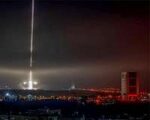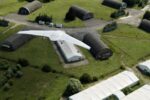Swedish Air Force JAS 39 Gripen fighters were scrambled to intercept and monitor two Russian Su-30SM aircraft flying near Swedish airspace over the Baltic Sea. The Russian jets were reportedly armed with Kh-31P anti-radiation missiles—an unusual loadout for such patrols—raising concerns about electronic warfare (EW) posturing and regional escalation.
Russian Su-30SMs Carrying Anti-Radiation Missiles Raise Alarm
On September 24, 2025, Swedish quick reaction alert (QRA) units based at F 17 Wing in Ronneby deployed JAS 39C/D Gripens to identify and shadow two Russian Aerospace Forces (VKS) Su-30SM multirole fighters operating in international airspace over the central Baltic Sea. According to the Swedish Armed Forces (Försvarsmakten), the Russian aircraft maintained a flight path that respected international boundaries but approached within close proximity of Gotland Island—a strategically sensitive area for Sweden and NATO.
What drew particular concern was the visible carriage of Kh-31P (NATO reporting name: AS-17 Krypton) anti-radiation missiles on the Su-30s’ underwing pylons. The Kh-31P is designed to home in on radar emissions from ground-based air defense systems such as Patriot or NASAMS batteries. Its presence suggests a simulated SEAD (Suppression of Enemy Air Defenses) posture—a provocative move during peacetime aerial patrols.
The Swedish Ministry of Defence confirmed the incident but refrained from speculating on intent. However, regional analysts point out that this is not standard behavior for routine VKS flights in the region. “This is clearly a signal,” said one Nordic defense official under condition of anonymity. “The loadout indicates an electronic warfare-oriented mission profile rather than a typical air policing sortie.”
Kh-31P Capabilities and Implications for Regional IADS
The Kh-31P missile is a high-speed anti-radiation weapon capable of speeds up to Mach 3.5 and ranges between 110–250 km depending on variant and launch profile. It uses passive radar homing to target enemy radar emissions across multiple frequency bands (D through G bands), making it effective against both legacy and modern surface-to-air missile systems.
- Speed: Up to Mach 3.5
- Range: ~110–250 km
- Warhead: ~90 kg HE fragmentation
- Guidance: Passive radar homing seeker
The missile’s deployment—even if not launched—can be interpreted as a rehearsal or signal of readiness to conduct SEAD operations against NATO-aligned Integrated Air Defense Systems (IADS). With Sweden set to formally join NATO by early 2026 following ratification delays from Hungary and Turkey earlier this year, its role in regional IADS—including integration into NATO’s NATINAMDS architecture—is increasing.
This incident may reflect Russia’s attempt to probe or deter that integration process by demonstrating potential counter-IADS capabilities.
Baltic Tensions Driving Increased Aerial Encounters
The Baltic region has witnessed a steady uptick in military activity since Russia’s full-scale invasion of Ukraine in February 2022. While most encounters remain professional and within international norms, there has been an increase in aggressive maneuvers and non-standard loadouts observed during VKS patrols originating from Kaliningrad Oblast—a heavily militarized exclave hosting Iskander-M ballistic missiles and S-400 SAM systems.
NATO’s Baltic Air Policing mission—currently led by Germany out of Šiauliai AB in Lithuania—has also reported increased QRA scrambles against Russian aircraft flying without transponder signals or flight plans. Sweden maintains its own independent QRA capability but coordinates closely with NATO via bilateral channels and NORDEFCO mechanisms.
The use of anti-radiation weapons during peacetime flights represents an escalation in signaling behavior rather than outright aggression. However, it complicates rules-of-engagement decisions for intercepting forces like Sweden’s Gripens or Finland’s F/A-18 Hornets now operating under NATO command structures since Helsinki joined the alliance in April 2023.
Gripen Intercepts Highlight Readiness but Also Risk
The JAS 39C/D Gripens deployed by Sweden are optimized for rapid-response interception missions thanks to their short takeoff capability, advanced PS-05/A pulse-Doppler radar (based on Ericsson/Ferranti Blue Vixen), and datalink integration via Link 16/STANAG protocols.
- Max speed: Mach 2+
- Combat radius: ~800 km with drop tanks
- Sensors: PS-05/A radar + IRST pod options
- Datalinks: Link 16 + national TIDLS network
- Munitions: AIM-120C AMRAAM / IRIS-T / Meteor capable
This incident underscores both their operational readiness and the risks inherent in intercepting heavily armed aircraft carrying standoff strike weapons like the Kh-31P. Although no hostile actions occurred during this encounter, close visual identification passes carry inherent danger when one side is equipped with active EW payloads or long-range AAMs such as R-77M variants now fielded by some VKS units.
NATO Integration Looming as Strategic Context Shifts
This latest intercept comes amid final preparations for Sweden’s full accession into NATO—a process accelerated after Russia’s invasion of Ukraine but delayed by political hurdles until late 2025. Once inside NATO command structures formally, Swedish assets including its Gripen fleet will be integrated into joint air policing rotations under Allied Air Command at Ramstein AB.
This will likely include participation in NATINAMDS exercises such as Astral Knight or Ramstein Alloy aimed at improving interoperability among allied IADS components across Scandinavia and the Baltics. It also means that future intercept incidents involving platforms like Su-30SMs carrying SEAD munitions could trigger more complex multinational response protocols rather than purely national-level reactions from Stockholm alone.
A Growing Electronic Warfare Chessboard Over the Baltics
The presence of EW-capable munitions like Kh-31Ps near Swedish territory signals an evolving contest not just over geography but over electromagnetic spectrum dominance in Northern Europe. Russia continues to invest heavily in airborne EW platforms like Il‑22PP ‘Porubshchik’ jammers while fielding GPS spoofing systems such as Tobol across Kaliningrad and Belarusian theaters.
NATO states have responded by enhancing GNSS resilience measures—including M-code adoption among U.S.-supplied platforms—and deploying mobile passive detection arrays capable of triangulating emission sources without revealing their own positions.
If these trends continue unchecked, future aerial encounters may involve not just visual ID but active jamming duels or attempts at radar blinding—raising both strategic risk levels and technical complexity for all parties involved.
Sustained Vigilance Required Amid Escalating Posture Signaling
This incident serves as another data point illustrating how conventional aerial encounters are being reshaped by electronic warfare considerations even outside declared conflict zones. As Sweden moves toward full NATO membership while maintaining its independent defense doctrine rooted in territorial integrity and high readiness posture, it must navigate increasingly ambiguous encounters where payload configurations speak louder than transponder codes.
Sustained investment in ISR fusion tools—including ELINT/SIGINT assets aboard Gulfstream S102B Korpen aircraft—and continued modernization of ground-based radars will be critical if Sweden hopes to maintain decision superiority amid rapidly evolving threat environments along its eastern flank.









